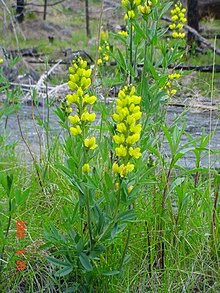| Thermopsis montana | |
|---|---|

| |
| Conservation status | |
 Apparently Secure (NatureServe) | |
| Scientific classification | |
| Kingdom: | Plantae |
| Clade: | Tracheophytes |
| Clade: | Angiosperms |
| Clade: | Eudicots |
| Clade: | Rosids |
| Order: | Fabales |
| Family: | Fabaceae |
| Subfamily: | Faboideae |
| Genus: | Thermopsis |
| Species: | T. montana |
| Binomial name | |
| Thermopsis montana Nutt. | |
| Varieties | |
| |
| Synonyms | |
List
| |
Thermopsis montana, the false lupin, mountain goldenbanner, golden pea, mountain thermopsis, or revonpapu, is a plant species which is native to the western United States. The Latin specific epithet montana refers to mountains or coming from mountains.
Description
Thermopsis montana is a perennial herb. The flowers are golden-yellow, growing in dense but elongate racemes on leafy stems which can grow up to about 3 feet (0.91 m) in height. Flowers bloom May to August. The leaves grow in triplicate formations.
The plant grows densely in meadows and in moist areas of the high plains, sometimes in association with sagebrush.
Cultivation
It is used as a medicinal plant, and as an ornamental plant in gardens. It is suspected of being poisonous. It is avoided by livestock.
References
- NatureServe (2024). "Thermopsis montana". Arlington, Virginia. Retrieved 27 August 2024.
- ^ "Thermopsis montana Nutt". Plants of the World Online. Royal Botanic Gardens, Kew. Retrieved 27 August 2024.
- BSBI List 2007 (xls). Botanical Society of Britain and Ireland. Archived from the original (xls) on 2015-06-26. Retrieved 2014-10-17.
- NRCS. "Thermopsis montana". PLANTS Database. United States Department of Agriculture (USDA). Retrieved 9 December 2015.
- ^ Whitney, Stephen (1985). Western Forests (The Audubon Society Nature Guides). New York: Knopf. p. 558. ISBN 0-394-73127-1.
- "Plant Name". extension.usu.edu. Archived from the original on 2023-01-31. Retrieved 2023-01-31.
- Archibald William Smith A Gardener's Handbook of Plant Names: Their Meanings and Origins, p. 239, at Google Books
- ^ "Lady Bird Johnson Wildflower Center - The University of Texas at Austin". www.wildflower.org. Retrieved 2023-01-31.
- ^ Taylor, Ronald J. (1994) . Sagebrush Country: A Wildflower Sanctuary (rev. ed.). Missoula, MT: Mountain Press Pub. Co. p. 108. ISBN 0-87842-280-3. OCLC 25708726.
- Thermopsis montana in the Native American Ethnobotany database.
- Fagan, Damian (2019). Wildflowers of Oregon: A Field Guide to Over 400 Wildflowers, Trees, and Shrubs of the Coast, Cascades, and High Desert. Guilford, CT: FalconGuides. p. 126. ISBN 978-1-4930-3633-2. OCLC 1073035766.
Further reading
- Pink, A. (2004). Gardening for the Million. Project Gutenberg Literary Archive Foundation.
External links
- Oregonstate.edu: Thermopsis montana Archived 2010-09-13 at the Wayback Machine
| Taxon identifiers | |
|---|---|
| Thermopsis montana |
|
This Sophoreae-related article is a stub. You can help Misplaced Pages by expanding it. |
- NatureServe apparently secure species
- Sophoreae
- Flora of the Western United States
- Flora of the Rocky Mountains
- Flora of Arizona
- Flora of Idaho
- Flora of Montana
- Flora of New Mexico
- Flora of Nevada
- Flora of Oregon
- Flora of Utah
- Flora of Wyoming
- Medicinal plants of North America
- Garden plants of North America
- Sophoreae stubs